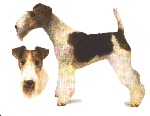|
SINCE THE 15TH
CENTURY terriers have been known in Britain, homeland of the Fox Terriers. These have been
described as small, sturdy, and game, noted for going to earth for their quarry. With the
introduction of foxhunting in the 18th century, these terriers found their place as useful
members of the hunt whose job it was to kill the fox. Thus it was that most of the
terriers were bred in hunt kennels and were developed according to the hunt master's
preference. A dash of this and a bit of that blood would be added to basic terrier stock.
Breeding records were not kept until after the introduction of the championship dog show
in the 1860s, so it is impossible to sort out the various breeds that form the ancestry of
the Fox Terriers. Educated guesses have it that the white English Terrier, Bulldog,
smooth-coated Black and Tan, Greyhound, and Beagle were used to develop thc smooth
variety, the first fox terrier. This breed was then crossed with the rough-coated Black
and Tan Terrier to create the wire-haired variety. These have been
described as small, sturdy, and game, noted for going to earth for their quarry. With the
introduction of foxhunting in the 18th century, these terriers found their place as useful
members of the hunt whose job it was to kill the fox. Thus it was that most of the
terriers were bred in hunt kennels and were developed according to the hunt master's
preference. A dash of this and a bit of that blood would be added to basic terrier stock.
Breeding records were not kept until after the introduction of the championship dog show
in the 1860s, so it is impossible to sort out the various breeds that form the ancestry of
the Fox Terriers. Educated guesses have it that the white English Terrier, Bulldog,
smooth-coated Black and Tan, Greyhound, and Beagle were used to develop thc smooth
variety, the first fox terrier. This breed was then crossed with the rough-coated Black
and Tan Terrier to create the wire-haired variety.
Paintings dating from the mid- 18th century depict dogs resembling thc fox terrier in both
coat types, but it was not until 1860 that any attempt was made to standardize the breed.
Smooth fox terriers were introduced to the public at the Birmingham show in 1862 and they
quickly won popularity as the working man's favourite. Later the wire-haired made its
debut, but until 1878 the two were classified as separate breeds. The smooth was known
simply as the Fox Terrier, a sporting breed. The wirehaired was called the Wire-Haired
Terrier and classified as a Non-Sporting breed. After the first breed standard was
written, both were granted separate terrier classification.
Shortly after its recognition the fox terrier came to America. Most notable import was Ch.
Nornay Saddler, a smooth, brought over by James Austin. Saddler was a dominant force in
the breed who produced at least one champion in every litter he sired. Among the first
breeds to be recognized by The Canadian Kennel Club, the comparative popularity of the two
varieties is evident in registration figures. In the years 1888-1889 there were 180
smooths registered in contrast to fourteen wires. Today those positions are reversed. |
     
|
